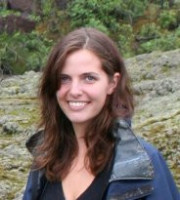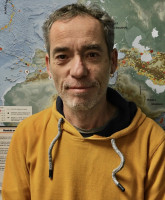Natural Catastrophes
Volcanic Eruption
AXA Chairs
United Kingdom
Understanding and mitigating volcanic catastrophes
Societies must be prepared to act upon scientific recommendations, and be bothered in advance about hazard mitigation, rather than take a chance on the event not happening again. However, convincing communities to prepare for the effects of natural disasters and volcanic eruptions in particular has proved challenging because of the nature of these events: they occur only infrequently, yet they may have far-reaching effects.
FROM MAGMA AT DEPTH TO DIFFUSE ASH CLOUDS IN THE ATMOSPHERE
Prof. Katharine Cashman scrutinizes explosive volcanic eruption, created by the rapid movement of gas-saturated magma from the subsurface to the atmosphere. Ash is ejected into the troposphere, creating ash plumes that travel with the prevailing weather systems. Currently, these ash plumes are tracked using a combination of satellite observations and volcanic ash transport and dispersion models. However, a recent review has identified severe deficiencies in both remote detection capabilities and the source parameters used as input to these models, which depend on empirical correlations of eruption parameters (plume height, mass eruption rate, fine ash content), such parameters varying substantially between eruptions. In particular, we are unable to predict the origin, abundance and dispersal properties of ash that is fine enough to remain suspended for several days.
This points to a fundamental gap in our understanding of how magma that contains dissolved volatiles deep below the Earth’s surface is transformed into fine particles that can circle the globe. Prof. Katharine Cashman intends to bridge this gap by developing a continuum view of volcanic systems that links magma properties at depth to properties of diffuse ash clouds in the atmosphere. Her research team will be conducting high pressure-temperature experiments using laboratory materials that behave in similar ways to magma. This will lead to an understanding of phenomena such as crystallization in the magma, providing detailed and practical insights into a process that happens under great temperature and pressure, beyond reach beneath the ground.
Experiments at room temperature will also be performed to observe processes that are not observable in the high pressure-temperature experiments. For example, the team will run experiments using golden syrup (a sugar syrup with a viscosity that is similar to magma) to study the movement of air (analogous to volcanic gases) through both viscous fluids and through suspensions of viscous fluids and particles (analogous to crystals). These experiments can identify conditions generating gas loss (and less explosive eruptions) or gas build-up (and more explosive eruptions). The novel approach taken by Prof. Katharine Cashman and her team involves considering how the physical characteristics of a volcanic ash cloud depend on an evolving set of internal and extensive parameters, such as magma composition, temperature and pressure or magma ascent path, regional stress field, and ice-cap melting.
“We wish to develop better scientific methods for predicting how volcanic plumes behave. This should benefit local communities who live near volcanoes, as well as airlines that need to know if it is going to be safe to fly”.
This should benefit local communities who live near volcanoes as well as airlines that need to know if it is safe to fly.
Prof. Katharine Cashman is a volcanologist with a long interest in the connection between chemical processes that control the formation of bubbles and crystals in rising magma and the physical processes that control volcanic eruptions. At the same time, her early work as Public Information Scientist for the US Geological Survey during the 1980-1986 eruption of Mount St. Helens introduced her to both the challenges and importance of not only improving volcanic hazard assessment, but also developing effective channels of communication to public officials and communities. She has spent most of her career as a professor at the University of Oregon, USA. Her work has taken her to volcanoes around the world to study lava flows in Hawaii and Italy, cinder cone eruptions in Mexico and Oregon, explosive eruptions in Alaska and Ecuador, and eruptions under the ocean in the western Pacific.
The Chair is based in the School of Earth Sciences at the University of Bristol, one of the leading centers for research and teaching in the Earth Sciences, ranked in the top four UK departments of its kind since 2001. Research activity is organized into six groups covering a wide range of topics from climate and environmental change, to paleobiology and geochemistry. Volcanic hazards and risks are one of the School’s leading interests and areas of expertise. The Chair is also part of the Cabot Institute at the University of Bristol, which brings together the University’s fundamental and responsive research on risks and uncertainties in a changing environment across science, social science and engineering.
By creating the AXA Chair in Volcanology, the AXA Research Fund places the University of Bristol at the forefront of programs that integrate fundamental volcanological research with assessment and implementation of volcanic risk assessment and risk reduction strategies. It will also solidify the multidisciplinary research themes envisioned for the newly developed Bristol Environmental Risk Research Centre.
To add or modify information on this page, please contact us at the following address: community.research@axa.com

Katharine
CASHMAN
Institution
University of Bristol
Country
United Kingdom
Nationality
American
Related articles
Natural Catastrophes
Climate Change
Wildfires
Climate Adaptation & Resilience
Global Warming
AXA Chair
Greece
AXA Chair in Wildfires and Climate
The consequences of climate change have never been as substantial and visible in such a wide range of places around ... Read more

Apostolos
VOULGARAKIS
Technical University of Crete
Natural Catastrophes
Volcanic Eruption
Joint Research Initiative
United Kingdom
2018.12.31
Volcanic Risk Assessment in Asia
Assessing volcanic ash hazard footprints in Asia In the language of insurance, a large volcanic ash plume represents what is... Read more

Susanna
JENKINS
